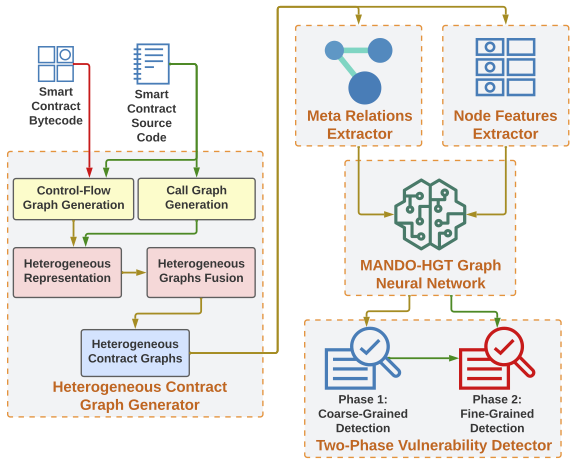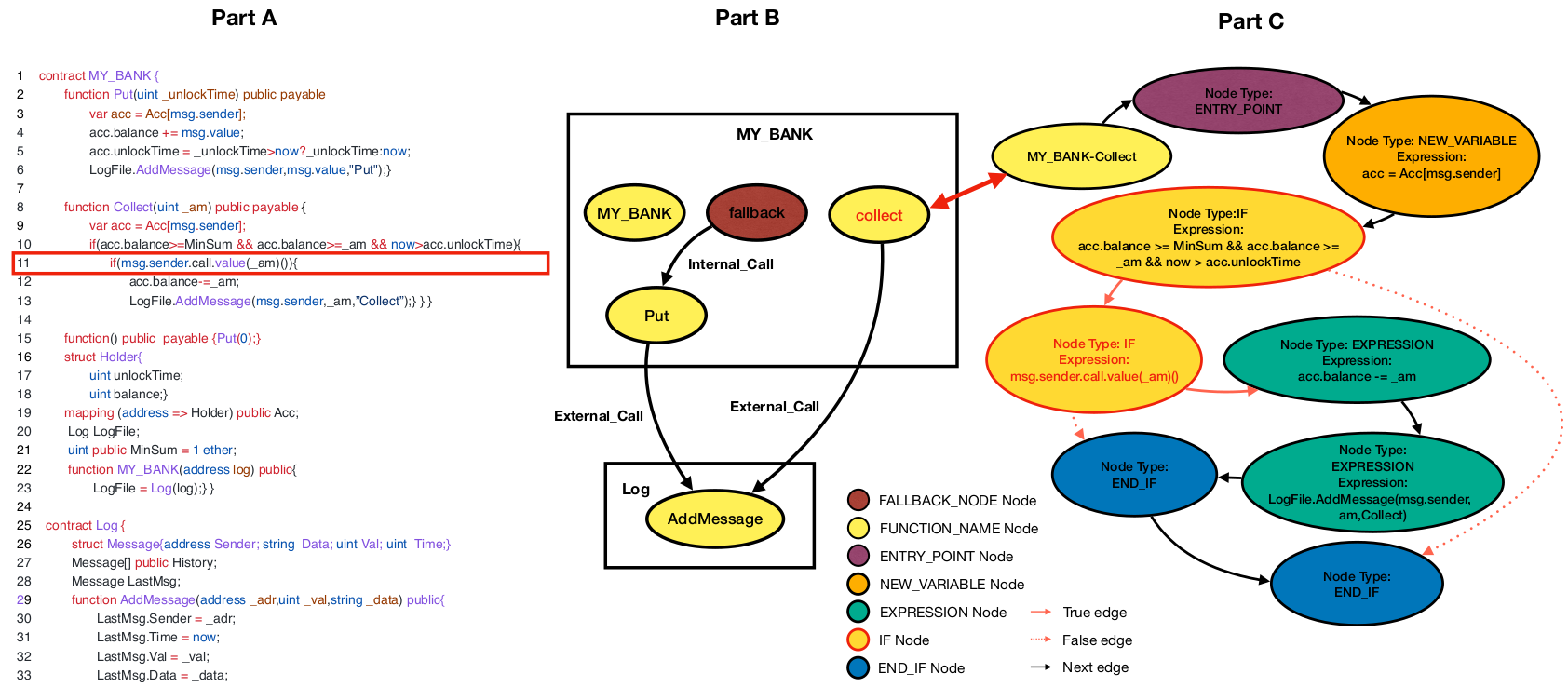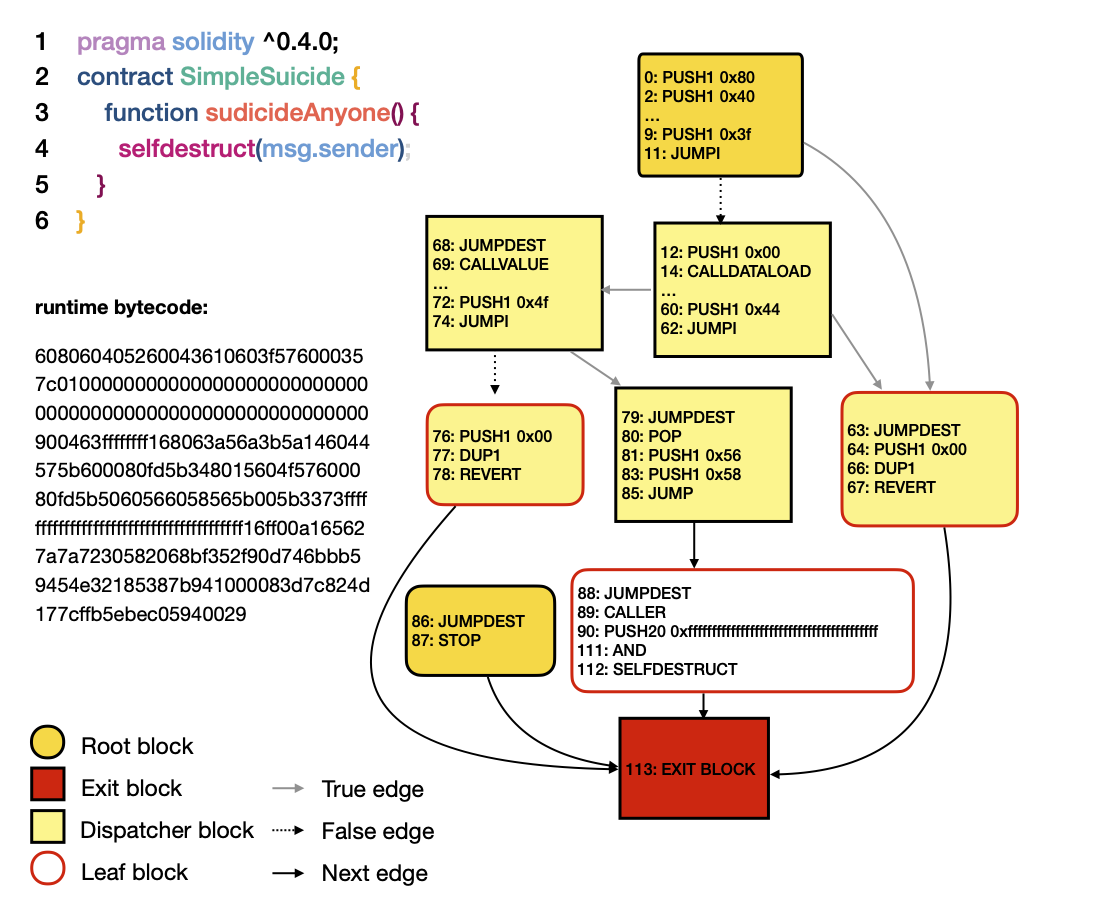This repository is the implementation of MANDO-HGT which should be applicable to either source code or bytecode/binary form of software programs to cater to different situations where the source code of the software may or may not be available.
Nguyen, H. H., Nguyen, N.M., Xie, C., Ahmadi, Z., Kudenko, D., Doan, T. N., & Jiang, L. (2023, May). MANDO-HGT: Heterogeneous Graph Transformers for Smart Contract Vulnerability Detection. In Proceedings of 20th International Conference on Mining Software Repositories (MSR' 23), Melbourne, Australia, 2023. Preprint
@inproceedings{nguyen2023msr,
author = {Nguyen, Hoang H. and Nguyen, Nhat-Minh and Xie, Chunyao and Ahmadi, Zahra and Kudenko, Daniel and Doan, Thanh-Nam and Jiang, Lingxiao},
title = {MANDO-HGT: Heterogeneous Graph Transformers for Smart Contract Vulnerability Detection},
year = {2023},
month = {5},
booktitle = {Proceedings of the 20th International Conference on Mining Software Repositories},
numpages = {13},
keywords = {vulnerability detection, smart contracts, source code, bytecode, heterogeneous graph learning, graph transformer},
location = {Melbourne, Australia},
series = {MSR '23}
}
- We prepared dataset for experiments.
- We used Solc compilation of Crytic-compile to compile EVM creation/runtime bytecode from the source code of smart contracts. Then we used EtherSolve to generate CFGs for bytecode.
We run all experiments on
- Ubuntu 20.04
- CUDA 11.1
- NVIDA 3080
Install python required packages.
pip install -r requirements.txt -f https://download.pytorch.org/whl/lts/1.8/torch_lts.html -f https://data.pyg.org/whl/torch-1.8.0+cu111.html -f https://data.dgl.ai/wheels/repo.htmlWe provied inspection scripts for Graph Classification and Node Classification tasks as well as their required data.
Training Phase
python -m experiments.graph_classification --epochs 50 --repeat 20To show the result table
python -m experiments.graph_classification --resultTraining Phase
python -m experiments.node_classification --epochs 50 --repeat 20To show the result table
python -m experiments.node_classification --result-
We currently supported 7 types of bug:
access_control,arithmetic,denial_of_service,front_running,reentrancy,time_manipulation,unchecked_low_level_calls. -
Run the inspection
usage: MANDO Graph Classifier [-h] [-s SEED] [-ld LOG_DIR]
[--output_models OUTPUT_MODELS]
[--compressed_graph COMPRESSED_GRAPH]
[--dataset DATASET] [--testset TESTSET]
[--label LABEL] [--checkpoint CHECKPOINT]
[--feature_extractor FEATURE_EXTRACTOR]
[--node_feature NODE_FEATURE]
[--k_folds K_FOLDS] [--test] [--non_visualize]
optional arguments:
-h, --help show this help message and exit
-s SEED, --seed SEED Random seed
Storage:
Directories for util results
-ld LOG_DIR, --log-dir LOG_DIR
Directory for saving training logs and visualization
--output_models OUTPUT_MODELS
Where you want to save your models
Dataset:
Dataset paths
--compressed_graph COMPRESSED_GRAPH
Compressed graphs of dataset which was extracted by
graph helper tools
--dataset DATASET Dicrectory of all souce code files which were used to
extract the compressed graph
--testset TESTSET Dicrectory of all souce code files which is a
partition of the dataset for testing
--label LABEL Label of sources in source code storage
--checkpoint CHECKPOINT
Checkpoint of trained models
Node feature:
Define the way to get node features
--feature_extractor FEATURE_EXTRACTOR
If "node_feature" is "GAE" or "LINE" or "Node2vec", we
need a extracted features from those models
--node_feature NODE_FEATURE
Kind of node features we want to use, here is one of
"nodetype", "metapath2vec", "han", "gae", "line",
"node2vec"
Optional configures:
Advanced options
--k_folds K_FOLDS Config for cross validate strategy
--test Set true if you only want to run test phase
--non_visualize Wheather you want to visualize the metrics-
We prepared some scripts for the custom MANDO structures bellow:
-
Graph Classication for Heterogeous Control Flow Graphs (HCFGs) which detect vulnerabilites at the contract level.
- GAE as node features.
python graph_classifier.py -ld ./logs/graph_classification/cfg/gae/access_control --output_models ./models/graph_classification/cfg/gae/access_control --dataset ./experiments/ge-sc-data/source_code/access_control/clean_57_buggy_curated_0/ --compressed_graph ./experiments/ge-sc-data/source_code/access_control/clean_57_buggy_curated_0/cfg_compressed_graphs.gpickle --label ./experiments/ge-sc-data/source_code/access_control/clean_57_buggy_curated_0/graph_labels.json --node_feature gae --feature_extractor ./experiments/ge-sc-data/source_code/gesc_matrices_node_embedding/matrix_gae_dim128_of_core_graph_of_access_control_cfg_clean_57_0.pkl --seed 1- Graph Classication for Heterogeous Call Graphs (HCGs) which detect vulnerabilites at the contract level.
- LINE as node features.
python graph_classifier.py -ld ./logs/graph_classification/cg/line/access_control --output_models ./models/graph_classification/cg/line/access_control --dataset ./experiments/ge-sc-data/source_code/access_control/clean_57_buggy_curated_0/ --compressed_graph ./experiments/ge-sc-data/source_code/access_control/clean_57_buggy_curated_0/cg_compressed_graphs.gpickle --label ./experiments/ge-sc-data/source_code/access_control/clean_57_buggy_curated_0/graph_labels.json --node_feature line --feature_extractor ./experiments/ge-sc-data/source_code/gesc_matrices_node_embedding/matrix_line_dim128_of_core_graph_of_access_control_cg_clean_57_0.pkl --seed 1- Graph Classication for combination of HCFGs and HCGs and which detect vulnerabilites at the contract level.
- node2vec as node features.
python graph_classifier.py -ld ./logs/graph_classification/cfg_cg/node2vec/access_control --output_models ./models/graph_classification/cfg_cg/node2vec/access_control --dataset ./experiments/ge-sc-data/source_code/access_control/clean_57_buggy_curated_0/ --compressed_graph ./experiments/ge-sc-data/source_code/access_control/clean_57_buggy_curated_0/cfg_cg_compressed_graphs.gpickle --label ./experiments/ge-sc-data/source_code/access_control/clean_57_buggy_curated_0/graph_labels.json --node_feature node2vec --feature_extractor ./experiments/ge-sc-data/source_code/gesc_matrices_node_embedding/matrix_node2vec_dim128_of_core_graph_of_access_control_cfg_cg_clean_57_0.pkl --seed 1- We used node classification tasks to detect vulnerabilites at the line level and function level for Heterogeneous Control flow graph (HCFGs) and Call Graphs (HCGs) in corressponding.
usage: MANDO Node Classifier [-h] [-s SEED] [-ld LOG_DIR]
[--output_models OUTPUT_MODELS]
[--compressed_graph COMPRESSED_GRAPH]
[--dataset DATASET] [--testset TESTSET]
[--label LABEL]
[--feature_compressed_graph FEATURE_COMPRESSED_GRAPH]
[--cfg_feature_extractor CFG_FEATURE_EXTRACTOR]
[--feature_extractor FEATURE_EXTRACTOR]
[--node_feature NODE_FEATURE] [--k_folds K_FOLDS]
[--test] [--non_visualize]
optional arguments:
-h, --help show this help message and exit
-s SEED, --seed SEED Random seed
Storage:
Directories \for util results
-ld LOG_DIR, --log-dir LOG_DIR
Directory for saving training logs and visualization
--output_models OUTPUT_MODELS
Where you want to save your models
Dataset:
Dataset paths
--compressed_graph COMPRESSED_GRAPH
Compressed graphs of dataset which was extracted by
graph helper tools
--dataset DATASET Dicrectory of all souce code files which were used to
extract the compressed graph
--testset TESTSET Dicrectory of all souce code files which is a
partition of the dataset for testing
--label LABEL
Node feature:
Define the way to get node features
--feature_compressed_graph FEATURE_COMPRESSED_GRAPH
If "node_feature" is han, you mean use 2 HAN layers.
The first one is HAN of CFGs as feature node for the
second HAN of call graph, This is the compressed
graphs were trained for the first HAN
--cfg_feature_extractor CFG_FEATURE_EXTRACTOR
If "node_feature" is han, feature_extractor is a
checkpoint of the first HAN layer
--feature_extractor FEATURE_EXTRACTOR
If "node_feature" is "GAE" or "LINE" or "Node2vec", we
need a extracted features from those models
--node_feature NODE_FEATURE
Kind of node features we want to use, here is one of
"nodetype", "metapath2vec", "han", "gae", "line",
"node2vec"
Optional configures:
Advanced options
--k_folds K_FOLDS Config cross validate strategy
--test If true you only want to run test phase
--non_visualize Wheather you want to visualize the metricsWe prepared some scripts for the custom MANDO structures bellow:
-
Node Classication for Heterogeous Control Flow Graphs (HCFGs) which detect vulnerabilites at the line level.
- GAE as node features for detection access_control bugs.
python node_classifier.py -ld ./logs/node_classification/cfg/gae/access_control --output_models ./models/node_classification/cfg/gae/access_control --dataset ./experiments/ge-sc-data/source_code/access_control/buggy_curated/ --compressed_graph ./experiments/ge-sc-data/source_code/access_control/buggy_curated/cfg_compressed_graphs.gpickle --node_feature gae --feature_extractor ./experiments/ge-sc-data/source_code/gesc_matrices_node_embedding/matrix_gae_dim128_of_core_graph_of_access_control_cfg_buggy_curated.pkl --testset ./experiments/ge-sc-data/source_code/access_control/curated --seed 1
-
Node Classification for Heterogeous Call Graphs (HCGs) which detect vulnerabilites at the function level.
-
The command lines are the same as CFG except the dataset.
- LINE as node features for detection access_control bugs.
python node_classifier.py -ld ./logs/node_classification/cg/line/access_control --output_models ./models/node_classification/cg/line/access_control --dataset ./experiments/ge-sc-data/source_code/access_control/buggy_curated --compressed_graph ./experiments/ge-sc-data/source_code/access_control/buggy_curated/cg_compressed_graphs.gpickle --node_feature line --feature_extractor ./experiments/ge-sc-data/source_code/gesc_matrices_node_embedding/matrix_line_dim128_of_core_graph_of_access_control_cg_buggy_curated.pkl --testset ./experiments/ge-sc-data/source_code/access_control/curated --seed 1
-
Node Classication for combination of HCFGs and HCGs and which detect vulnerabilites at the line level.
- node2vec as node features.
python node_classifier.py -ld ./logs/node_classification/cfg_cg/node2vec/access_control --output_models ./models/node_classification/cfg_cg/node2vec/access_control --dataset ./experiments/ge-sc-data/source_code/access_control/buggy_curated --compressed_graph ./experiments/ge-sc-data/source_code/access_control/buggy_curated/cfg_cg_compressed_graphs.gpickle --node_feature node2vec --feature_extractor ./experiments/ge-sc-data/source_code/gesc_matrices_node_embedding/matrix_node2vec_dim128_of_core_graph_of_access_control_cfg_cg_buggy_curated.pkl --testset ./experiments/ge-sc-data/source_code/access_control/curated --seed 1
-
We also stack 2 HAN layers for function-level detection. The first HAN layer is based on HCFGs used as feature for the second HAN layer based on HCGs (It will be deprecated in a future version).
python node_classifier.py -ld ./logs/node_classification/call_graph/node2vec_han/access_control --output_models ./models/node_classification/call_graph/node2vec_han/access_control --dataset ./ge-sc-data/node_classification/cg/access_control/buggy_curated --compressed_graph ./ge-sc-data/node_classification/cg/access_control/buggy_curated/compressed_graphs.gpickle --testset ./ge-sc-data/node_classification/cg/curated/access_control --seed 1 --node_feature han --feature_compressed_graph ./data/smartbugs_wild/binary_class_cfg/access_control/buggy_curated/compressed_graphs.gpickle --cfg_feature_extractor ./data/smartbugs_wild/embeddings_buggy_currated_mixed/cfg_mixed/gesc_matrices_node_embedding/matrix_node2vec_dim128_of_core_graph_of_access_control_compressed_graphs.pkl --feature_extractor ./models/node_classification/cfg/node2vec/access_control/han_fold_0.pth- We automatically run testing after training phase for now.
- You also use tensorboard and take a look the trend of metrics for both training phase and testing phase.
tensorboard --logdir LOG_DIR





